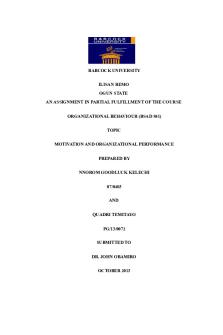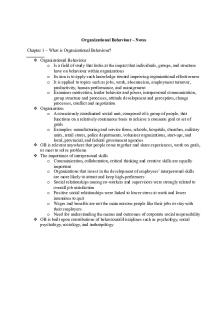Organizational behaviour PDF

| Title | Organizational behaviour |
|---|---|
| Author | Fanny Kesti |
| Course | Organisationspsykologi |
| Institution | Hanken - Svenska handelshögskolan |
| Pages | 67 |
| File Size | 2.7 MB |
| File Type | |
| Total Downloads | 10 |
| Total Views | 156 |
Summary
Download Organizational behaviour PDF
Description
Organizational behaviour 1. What is Organizational Behaviour? Until the late 1980’s business school has emphasized the technical aspects of management, but since then they have started to recognize human behaviour and people skills. Surveys have also shown that the lack of interpersonal skills often is the reason why someone fails to advance. The keys to a successful business are: having superior financial performance, developing managers interpersonal skills to keep highperforming employees and working with relationships to enhance employees job satisfaction. Research has shown that positive social relationships are associated with lower stress, higher job satisfaction and lower intentions to quit. Also, having a supportive dialogue with managers, enhances the social responsibility awareness. This is why you need both technical skills and good people skills to succeed as a manager in today’s competitive and demanding workplace. Manager = person who achieves goals through other people by making decisions, allocating resources and directing the activities of others to attain the goals The demands on managers have increased: they have seven direct reports, earlier it has been five and additionally the manager has less management time to spend with them. The work of a manager can be condensed into four main activities: planning, organizing, leading and controlling. Planning = a process that includes defining goals, establishing strategy and developing plans to coordinate activities Organizing = determining what tasks are to be done, who is to do them, how the tasks are to be grouped, who reports to whom and where decisions are to be made Leading = a function that includes motivating employees, directing others, selecting the most effective communication channels and resolving conflicts Controlling = monitoring activities to ensure they are being accomplished as planned and correcting any significant deviations Henry Mintzberg studied managers and concluded his observations into ten different managerial roles divided into three behaviours : 1. Interpersonal - Figurehead, Leader & Liaison 2. Informational - Monitor, Disseminator & Spokesperson 3. Decisional- Entrepreneur, Disturbance handler, Resource allocator & Negotiator The interpersonal role performs duties that are ceremonial and symbolic, but is also in charge for leadership duties such as hiring, training, motivating and disciplining employees. Additionally the role includes contacting and fostering internal and external relationships with others who provide valuable information. The informational role includes collecting information from the outside media and public, transmitting information on the inside and lastly representing the organizations to outsiders. The role that requires making choices, taking corrective actions and allocating resources is the decisional role. This part is also responsible for negotiating with other units.
Researchers have identified a number of skills that differentiate effective from ineffective managers: 1. Technical skills = the ability to apply specialized knowledge or expertise 2. Human skills = the ability to work with, listen to, understand and motivate people both individually and in groups 3. Conceptual skills = the mental ability to analyze and diagnose complex situations, make decisions and be able to execute the plan you have made with both existing processes and new ideas Fred Luthans studied the difference between effective and successful managers engaging in traditional management, communication, human resource management and networking. The managers who were successful and moved up quickly were the most engaged in networking and the least engaged in HRM. The effective managers put the most time into communicating and not so much in networking. This challenges the assumption that promotions are based on performance and illustrates the importance of networking skills. Traditional management = decision making, planning and controlling Communication = exchanging routine information and processing paperwork Human Resource Management = motivating, disciplining, managing conflicts, staffing and training Networking = socializing, politicking and interacting with outsiders Organizational behaviour studies how to best do the things that managers should do. It studies the impact individuals, groups and structure have on behaviour within organizations, for the purpose of applying such knowledge toward improving an organization’s effectiveness. OB is the study of what people do in an organisation and the way their behaviour affects the organization’s performance. The situations are employment-related and contain job satisfaction, absenteeism, employment turnover, productivity, human performance and management. Systematic study = looking at relationships, attempting to attribute causes and effects and drawing conclusions based on scientific evidence Evidence-based management (EBM) = the basing of managerial decisions on the best available scientific evidence Behaviour is generally predictable and the systematic study of behaviour helps in making reasonable, accurate predictions. When you add EBM and systematic studies, it adds to your intuition about what makes others and ourselves tick. Just watch out for making all decisions with your gut instinct, since humans tend to overestimate the accuracy of what we think we know. And remember that sometimes a firm can succeed just for being at the right place at the right time - it is with the systematic approach we can separate the wheat from the chaff. Management by walking around is mostly a myth, but an organizational principle made famous in 1982. The idea is based on managers walking around their departments to observe, converse and hear from employees. It is being claimed that this management style increases employee engagement and safety as well as supports the understanding of company issues. The idea is limited by the modern practices focused on trust and relationships as well as limited hours, focus and application. Sometimes you need to
think about what is urgent versus important to have an effective management. Big data originated in the marketing department of online retailers and helped stores to create more targeted marketing strategies, with the information about what people buy, how they navigate the site, what influences them and what their preferences are. The statistics helped companies to identify which statistics were persistent and predictive, only to develop algorithms to forecast customers’ next buy. Today big data is used to calculate risks, predicting subscribers behaviour and possible revenue as well as selecting preferred samples. Some companies even live on selling data to other parties. But big data also has some limitations including the issue of privacy. Companies might also risk offending the people they are trying to influence: employees and customers. Therefore ít is necessary to keep the innumerable variables in human behaviour and realize that management is more than the sum of data, but that evidence is a great support to your intuition and experience. The disciplines that contribute to the OB field are: - Psychology: seeks to measure, explain and change the behaviour of humans and animals - Social psychology: a mix of psychology and sociology that focus on people’s influence - Sociology: studies people in relation to their social environment or culture - Anthropology: learns about human beings and their activities within organisations and cultures The fact that humans don’t act the same way means that OB concepts must reflect situational or contingency conditions in its predictions. Often you can find both general effects and contingencies and you will understand OB better when you realize how both often guide people's behaviour. The biggest challenges, but also opportunities for OB are: - Dramatic changes in organizations - Economic pressure - Employees that are getting older - Different attitudes towards work - A diversified workforce - How employees react to customer service - The time and place of work - Global competition - More women in the workforce - Increased foreign assignments - Work-life balance - Ethical dilemmas and choices - Networked organizations - Social media Positive organizational scholarship = an area of OB research that concerns how organizations develop human strengths, foster vitality and resilience and unlock potential → identifies what’s good about organisations and their employees by studying engagement, hope, optimism and resilience. Vacation Deficit Disorder Some ways you can maintain your well-being and productivity:
-
Recognize your feelings Identify your tendency for burnout Talk about your stressors Build in high physical activity Take brief breaks throughout your day Take your vacation
Attitude = the evaluations employees make about objects, people and events, both positive and negative Stress = an unpleasant psychological process that occurs in response to environmental pressures Task performance = the combination of effectiveness and efficiency at doing core job tasks, the most important human output contributing to organizational effectiveness Organisational citizenship behaviour (OCB) = citizenship behaviour, discretionary behaviour that contributes to the psychological and social environment of the workplace Withdrawal behaviour = the set of actions employees take to separate themselves from the organization Turnover rates vary between countries and depend on the economic situation. Turnover includes voluntary terminations by the employee and involuntary terminations by the employer with and without a cause. About half of the turnover comes from quitting and you might question if that number is good or bad. For example if the poor performers leave, it can be a positive thing for the company. Quitting is also related to persons being optimistic about their outside prospects, not just negative about their current ones. However, it is important to remember that negative job attitudes, emotions, moods and interactions also may be the reasons for counterproductive behaviour and quitting.
Group cohesion = the extent to which members of a group support and validate one another while at work → a cohesive group is one that sticks together with common goals and mutual trust Group functioning = the quantity and quality of a group’s work output, the sum of the individual task performances, good group cohesion could lead to good group functioning Productivity = the combination of the effectiveness and efficiency of an organization Effectiveness = the degree to which an organization meets the needs of its clientele or customers Efficiency = the degree to which an organization can achieve its ends at a low cost Organizational survival = evidence that an organization is able to exist and grow over the long term Managers need to develop their interpersonal, or people, skills to be effective in their jobs. Organizational behaviour (OB) investigates the impact that individuals, groups and structure have on behaviour within an organization, and it applies that knowledge to make organizations work more effectively. Managers should resist relying on generalizations, instead they should get to know the person and the context. OB can improve your employees’ work quality and productivity by showing you how to empower your employees, design and implement change programs, improve customer service and help your employees balance work-life conflicts.
2. Diversity in Organizations Diversity - Demographic characteristics such as race, age, ethnicity, religion or gender, mostly reflect surface-level diversity, not thoughts and feelings - Evidence has shown that people are less concerned about demographic differences if they see themselves as sharing more important characteristics such as personality and values, also known as deep-level diversity - Discrimination = noting of a difference between things; often we refer to unfair discrimination, which means making judgements about individuals based on stereotypes regarding their demographic group - Stereotyping = judging someone on the basis of our perception of the group to which that person belongs → may affect perpetrators of discrimination and how the victims see themselves -
Stereotype threat = the degree to which we intentionally agree with the generally negative stereotyped perceptions of our groups → making people their own worst enemies and even
-
-
over-identify, overcompensate or exaggerating the stereotype To minimize stereotype threat organisations can increase awareness of how stereotypes may be perpetuated, reduce differential and preferential treatment, ban stereotyped practices and messages, confront microaggressions against minority groups and adopt transparent practices The effects of discrimination can vary depending on organizational context and the personal biases of employees
Different forms of discrimination Discriminatory policies or practices
Denying equal opportunities or rewards
Sexual harassment
Unwanted sexual advances or conduct
Intimidation
Overt threats or bullying
Mockery and insult
Jokes or negative stereotypes
Exclusion
Exclusion of certain people from job opportunities, social events or informal mentoring
Incivility
Disrespectful treatment, interruptions and ignoring
Biographical characteristics = personal characteristics - such as age, gender, race and length of tenure that are objective and easily obtained from personnel records. These characteristics are representative of surface level diversity - As a general rule, many biographical differences are not important to actual work outcomes - Age is not correlated to absenteeism - Older workers: - Might bring experience, judgement, a strong work ethic and commitment to quality, even though they also are perceived as less adaptable and less motivated to learn new technology - Have lower turnover since their skills are more specialized and the organizations have better benefits for workers with longer tenure - Are better to avoid severe errors but lack of creativity - Are more satisfied as positive moods increases with age - Gender has no effect on leadership, performance, problem-solving ability, analytical skills or learning ability even though men have a slighter higher math ability and women verbal ability - Race and ethnicity relates to hiring decisions, performance evaluations, pay and workplace discrimination, but it is often reported by minorities - Disabilities can be observable or hidden (sensory disabilities, autoimmune disorders, chronic illness, cognitive or learning impairments, sleep disorders or psychological challenges) - Positive diversity climate = in an organisation, an environment of inclusiveness and acceptance of diversity → increased sales, less turnover and better overall performance Other differentiating characteristics - Represent deep-level differences that provide opportunities for workplace diversity - Tenure, meaning time spent in a job, organization or field, is a good predictor over employee productivity, however it is not linear using the NFL analogy - Religion should not be a reason for discrimination and yet Muslims have experienced shorter and more hostile interviews when wearing islamic attires - Faith can be an employment issue wherever religious beliefs prohibit or encourage certain behaviors
-
Full acceptance of sexual orientation and gender identity is still a work in progress People choose their cultural identity and how closely they observe the norms of that culture An organisation seeking to be sensitive to cultural identities should create an individualized approach to practises and norms to provide workplace flexibility
Ability = an individual’s capability to perform the various task in a job - We all have different strengths and weaknesses, that makes us relatively superior or inferior to others in performing certain tasks or activities - A manager should understand the differences and try to increase that a given employee will perform well based on their intellectual and physical abilities - Intellectual abilities = the capacity to do mental activities - thinking, reasoning and problem solving - Assessing intellectual ability is difficult (IQ, SAT, ACT) - The dimensions are number aptitude, verbal comprehension, perceptual speed, inductive reasoning, deductive reasoning, spatial visualisation and memory
-
Intelligence dimensions are positively correlated, but not perfectly, and affect happiness and satisfaction negatively since smart people are more critical and expect more Physical abilities = the capacity to do tasks that demand stamina, dexterity, strength and similar characteristics - Nine basic physical abilities: - Strength factors: dynamic strength, trunk strength, static strength and explosive strength - Flexibility factors: extent flexibility and dynamic flexibility - Other factors: body coordination, balance and stamina
Diversity management = the process and programs by which managers make everyone more aware of and sensitive to the needs and differences of others
-
One method of enhancing workforce diversity is to target recruitment messages to specific demographic groups that are underrepresented in the workforce → attracting
-
Some companies have been actively working toward recruiting less-represented groups → selecting In the selection process it is important to use well-defined protocols for assessing the applicants talent → developing
-
Training programs and a positive diversity climate will affect turnover positively → retaining
-
Smart and ambitious people in a homogenous group is more effective than a heterogenous group where some aren’t interested in group work at all Groups with different types of expertise and education are also more effective than a homogenous group, however it is important to emphasize the similarities among the members Managers can improve recruitment by making the selection systems more transparent and provide training for those employees who have not had adequate exposure to diversity in the past Diversity management must be an ongoing commitment that crosses all levels of organisations
-
Implications for managers - Understand the anti-discrimination policies thoroughly - Assess and challenge your stereotypes - Consider individual capabilities - Understand and respect the unique biographical characteristics of each individual
3. Attitudes and job satisfaction The satisfaction for job arrangements depends on your expectations and the work congruence. Research has shown that when an individual wants to work more and is offered to work more, job satisfaction increases. However, it is important that the individual gets paid for these extra hours. Also job insecurity, such as the lack of an employer’s medical insurance plan, is strongly negatively related to job satisfaction. As you can see, what makes a job satisfying is a bit more complex: schedule compatibility and job security, but also a lot more important attitudes affect the experienced satisfaction. Attitude = evaluative statements or judgements concerning objects, people or events → reflect how we feel about something → are complex and have three inseparable components Attitudes are assumed to have three components: 1. Cognitive component - description of or believe in the way things are 2. Affective component - emotional or feeling segment reflected in the statement 3. Behavioural component - an intention to behave in a certain way toward someone or something
-
Organization attitudes are important to understand how they are formed, how they impact job behaviour and how they might be changed Attitudes might predict future behaviour and cases of attitude following behaviour illustrate the effects of cognitive dissonance contradictions individuals might perceive between their a...
Similar Free PDFs
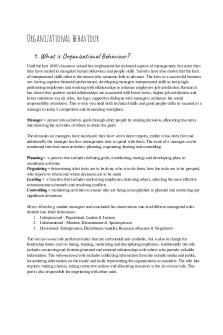
Organizational behaviour
- 67 Pages

Organizational Behaviour
- 2 Pages
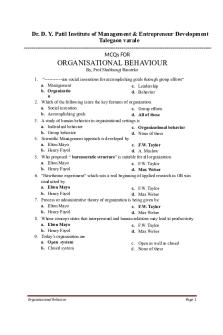
Organizational Behaviour mcqs
- 27 Pages
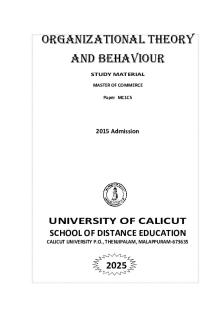
Organizational theory and behaviour
- 186 Pages
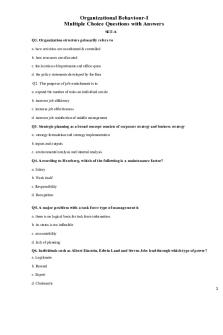
Organizational Behaviour MCQ SET
- 20 Pages
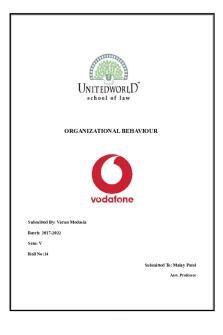
Organizational Behaviour Project
- 15 Pages

Chapter 2 ORGANIZATIONAL BEHAVIOUR
- 23 Pages

Organizational Behaviour Glossary
- 17 Pages
Popular Institutions
- Tinajero National High School - Annex
- Politeknik Caltex Riau
- Yokohama City University
- SGT University
- University of Al-Qadisiyah
- Divine Word College of Vigan
- Techniek College Rotterdam
- Universidade de Santiago
- Universiti Teknologi MARA Cawangan Johor Kampus Pasir Gudang
- Poltekkes Kemenkes Yogyakarta
- Baguio City National High School
- Colegio san marcos
- preparatoria uno
- Centro de Bachillerato Tecnológico Industrial y de Servicios No. 107
- Dalian Maritime University
- Quang Trung Secondary School
- Colegio Tecnológico en Informática
- Corporación Regional de Educación Superior
- Grupo CEDVA
- Dar Al Uloom University
- Centro de Estudios Preuniversitarios de la Universidad Nacional de Ingeniería
- 上智大学
- Aakash International School, Nuna Majara
- San Felipe Neri Catholic School
- Kang Chiao International School - New Taipei City
- Misamis Occidental National High School
- Institución Educativa Escuela Normal Juan Ladrilleros
- Kolehiyo ng Pantukan
- Batanes State College
- Instituto Continental
- Sekolah Menengah Kejuruan Kesehatan Kaltara (Tarakan)
- Colegio de La Inmaculada Concepcion - Cebu
